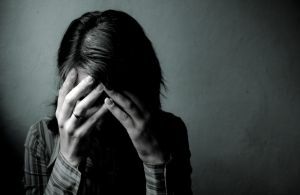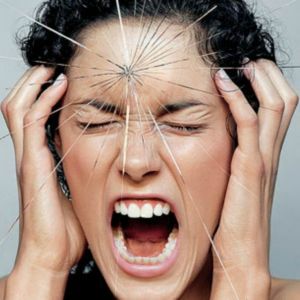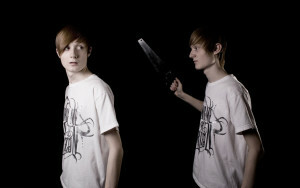 Paranoid schizophrenia is one of the varieties of schizophrenia. The most obvious symptom of the disease and its distinctive feature can be called prevalent among other symptoms of hallucinations and delusions. According to statistics, it is this form of schizophrenia - the most common.
Paranoid schizophrenia is one of the varieties of schizophrenia. The most obvious symptom of the disease and its distinctive feature can be called prevalent among other symptoms of hallucinations and delusions. According to statistics, it is this form of schizophrenia - the most common.
In 1912 the German psychiatrist Emil Krepelin defined paranoid conditions as a separate disease. As part of his research, paranoid psychosis was identified as one of the manifestations of schizophrenia, paranoia is a separate illness and paranoia due to negative psychological influences from outside.
Alternative names: paranoid, paranoid schizophrenia.
Contents
- Primary characteristic
-
- research
- research
- risk factors
- risk characteristics and typical portrait of the patient
- Features of the clinical picture
- flow types Border states
- Diagnostic criteria
- Therapy methods
-
Primary characteristic
The brain of a patient with paranoid schizophrenia generates a variety of forms and speciesdelusions, but, in general, his perception of the surrounding

Betty Page
world is holistic, not scrappy. However, getting along with this disease is difficult, without treatment a person gradually loses the ability to live a normal life. Such a form of schizophrenic disorder suffered such famous people as Betty Page, L. Aldridge, T. Harrell.
The international classification of diseases of the tenth revision appointed paranoid schizophrenia code number F20.0.Depending on the observed symptoms, distinguish affective and catatonic forms of the disease. If feelings of fear, anxiety, depressive states are more pronounced, it is an affective form, if there are violations of verbal abilities, willpower, then catatonic.
Proper treatment is directly related to the exact diagnosis, but even with the correct diagnosis and therapy, the clinical picture of the disease is very diverse.
Variations of percolation: continuous flow, episodic with an increasing or stable defect, seizure, incomplete and complete remission.
Research on
Interest in all types of schizophrenic disorders is high among psychiatrists, in many respects, precisely because of the diversity of the clinical picture and the difficulties in diagnosing and treating. The study of the paranoid form of schizophrenia involved:
- Carl Kleist divided schizophrenic disorders into typical and atypical, extensive and combined forms;
- Emil Krepelin singled out paranoia as an independent disease;
- Gaetano Benedetti voiced such a concept as a hallucinatory-paranoid syndrome, and also considered variants of the onset of the disease( slow or acute) and its course( linear or wavy);
- Goh Alfred assumed that with the development of the disease, delirium progresses, reaches absurdity and takes acute forms, and personality under the influence of delirium can change radically;
- Carl Leonhard studied endogenous psychoses in general, relating paranoid schizophrenia to a systematized;
- Wilhelm Meyer-Gross considered the disease multifaceted, with many transitional forms and conditions, one of the forms he called depressive-paranoid syndrome with a constant sense of sinfulness and the proximity of the end of the world.
Risk Factors
It can not be asserted that a psychological trauma inevitably leads to paranoid schizophrenia. Or that the cause of the disease is unequivocally hidden in genetics. All the theories are in the process of studying, you can identify only the likely causes of paranoid and hallucinatory disorder:
- genetics;
- impaired development of the fetus in the womb due to viruses or malnutrition;
- disturbances in the production of dopamine, serotonin, norepinephrine, glutamate, acetylcholine;
- psychotrauma;
- abuse of drugs, alcohol;
- stress;
- birth from elderly parents;
- lives in a major metropolis.
Characteristics of the debut of the disease and a typical portrait of the patient
 The onset of the disease is observed early, in the interval between 20 and 30 years. Often an example of the manifestation of paranoid schizophrenia is constant jealousy. The patient torments the partner with questions about where he was and what he did, suspects of treason, offended by any communication with other persons of the opposite sex. The person becomes more and more suspicious, and with the progress of the disease feels full conviction of treason.
The onset of the disease is observed early, in the interval between 20 and 30 years. Often an example of the manifestation of paranoid schizophrenia is constant jealousy. The patient torments the partner with questions about where he was and what he did, suspects of treason, offended by any communication with other persons of the opposite sex. The person becomes more and more suspicious, and with the progress of the disease feels full conviction of treason.
At the initial stage of development there are slight changes in the patient's personality: he moves away from people, even close ones, his emotional reactions become meager, obsessive thoughts appear. Then there may be nonsense, hallucinations and Kandinsky-Clerambo syndrome, pseudo-hallucinations, mental automatisms.
The onset of the disease( it is also called debut, debut) can be different, there are 6 variants, each of which has its own beginning:
- The first option is paranoid nonsense .A person develops his own conclusions, which have nothing in common with reality, overvalued ideas, focuses on them. Initially, these thoughts are based on some fact, but gradually it is forgotten, turning the patient into a tense, anxious person. Personality is transformed into a more detailed one, with certainty of one's own right, pedantry reaches its limit to the limit.
- The characteristic beginning of the second variant is the appearance of obsessive states of , ritual actions of .Their patient performs in the chosen order, when impossible to perform is very nervous.
- The third option is a hysterical debut. Personality changes, the patient becomes closed. Hysterical disorders can occur on the smallest household occasion.
- The characteristic beginning of the fourth variant is the simultaneous occurrence of both hysterical and obsessive states of .
- In the fifth scenario, the astheno-hypochondriacal develops. Asthenia is very pronounced.
- The characteristic beginning of the sixth variant occurs with loss of a solid sense of the self "AS" .The patient is depersonalized, the personality is split and changed.
Features of the clinical picture
Paranoid schizophrenia has the characteristic signs, manifested in human behavior and symptoms, in the event of which it is necessary to consult a specialist:
- appearance of psychological automatisms;

- nonsense of any type;
- hallucinations of different types;
- unreasonable anger and rage;
- insensitivity, coldness, indifference to relatives;
- strong sense of anxiety, thoughts of suicide;
- aggressiveness to others;Megalomania;
- Kandinsky-Clerambo syndrome: confidence that someone is manipulating;
- affective disorders: confidence in the presence of super-abilities, omnipotence, immortality;
- passivity, loss of interest in life, social inapplicability, interesting no longer seems interesting, a person stops taking care of himself;
- hyperactivity or retardation;
- a few words.
The main symptoms are delusions and hallucinations of all kinds.
Types of
Current There are two types of paranoid schizophrenia, differing in symptoms:
- First view: crazy .Here we are considering delusions of any kind, based on any idea. The main thing is that the patient's ideas about reality are false. The patient often becomes aggressive, but, on the whole, his emotional reactions are adequate. There are difficulties with a clear formulation and expression of their thoughts.
- The second kind: hallucinatory .The patient hears voices or smells, which are not in reality. Hallucinations of any kind cause a lot of problems in everyday life, a person acquires uncharacteristic earlier anxiety, suspiciousness. If the disease is not treated, the prognosis for the patient is extremely unfavorable.
Variants of paranoid schizophrenia: continuous flow, episodic with an increasing defect, episodic with a stable defect, episodic remitting, incomplete remission, complete remission.
Border states
Delirium is a false representation of a person about reality, it can concern many spheres. It is very difficult to classify delusions, because the possibilities of the human mind generating delusional ideas are extremely wide. And yet, professionals identify the following varieties of delusional conditions that are inherent in the paranoid type of schizophrenia:
- Persecution Craze .The patient believes that he is being watched, everywhere cameras and wiretapping, he is afraid to leave the house once more, sees
 an enemy or a spy in every counter.
an enemy or a spy in every counter. - Mania of greatness .The patient praises himself above the rest, is confident in the presence of super abilities, thinks that he can treat illnesses or see the future.
- Delirium of bodily changes .He is more often exposed to women: they think that they are too thin or too full. There is a fear of eating or, conversely, manic absorption.
- Pathological jealousy .The patient suspects his partner of treason, does not let him see his friends, looks at mail and personal messages, checks things.
- Delirium of exposure .The patient believes in conspiracy theories that someone manipulates him, actively proves his conclusions to others.
Varieties of attendant hallucinations:
- Spotting is divided into simple( the person sees points, shapes, spots, lines), the objects( see specific things), microscopic( objects smaller than they are), macroscopic( sees objects too large), autoscopicsees himself or his double), zooscopic( sees animals and birds), extracampal( feels the presence of someone from behind).
- When auditory hallucinations the patient hears voices, most often they are disposed negatively, scolded or teased him.
- Hallucinations smell and taste - a rare phenomenon, as well as tactile. The patient may seem to be touched, that it is too hot or cold around, that the food is disgusting to taste.
- With navelopathy , the patient may feel a squeezing, sudden pain in one part or another of the body, for no apparent reason.

Diagnostic criteria
For the diagnosis it is necessary that the main signs of schizophrenia are observed - nonsense and hallucinations. The diagnosis is made after a complete clinical examination, confirmation of the presence of symptoms and a differential diagnosis.
The presence of delusions and hallucinations of any kind is very important for the diagnosis, they must be clearly expressed. In comparison with the manifestation of delusional states and hallucinations, speech disorders, will and emotions in the paranoid form of schizophrenia are less pronounced.
The specialist should exclude a drug or epileptic psychosis, they have similar symptoms. With the help of differential diagnosis, one should also exclude alcoholic delirium. The final diagnosis is not made immediately, but only after a year of monitoring the patient.
The main diagnostic rule of schizophrenia is "everything that is unusual".
Therapy methods
Treatment of paranoid schizophrenia should be carried out on the following fronts: medications, psychotherapy, EST( electroconvulsive therapy), social work.
 Drug treatment is carried out in 3 stages: active therapy, stabilizing and supporting. Some drugs used: haloperidol, ziprasidone, aripiprazole, olanzapine, tizercin, aminazine.
Drug treatment is carried out in 3 stages: active therapy, stabilizing and supporting. Some drugs used: haloperidol, ziprasidone, aripiprazole, olanzapine, tizercin, aminazine.
It is almost impossible to cure the ailment, but it is quite possible to stop the symptoms and achieve a stable remission. The earlier treatment is started, the more favorable its outcome. It is very important in the treatment that relatives support the patient, otherwise there is a chance that he will give up all hope of improvement.
In the absence of treatment, the prognosis is unfavorable. But this can be said about many diseases, in the case of paranoid schizophrenia there is a chance of a successful outcome, if the symptoms are observed in a woman, the disease started abruptly, and in the family previously no one suffered from it, the forecast is the best.
The result of treatment will be better if the patient is provided with friendly and family support and worse if he is criticized and sent to the doctor forcibly.
The disease is extremely difficult, few can cope with it. But there are living examples: John Nash, about whom subsequently removed the "Games of Reason", suffered from paranoid schizophrenia. He was able to share hallucinations and reality, although he refused medication.



